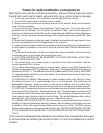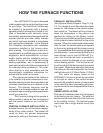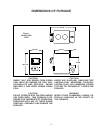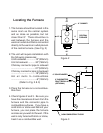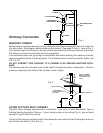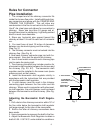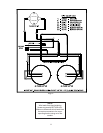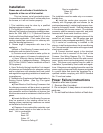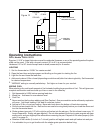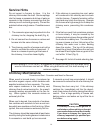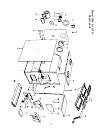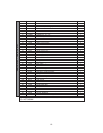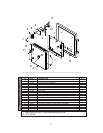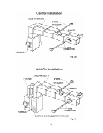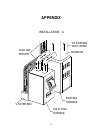12
Power Failure Instructions
Operation after loss of power:
1. Remove filter if provided
2. Do not expect to keep home at normal tem-
peratures.
3. Do not load fuel above bottom of feed door.
Installation
Please see all methods of Installation in
Appendix at the rear of this booklet.
Pipe to combustible:
Sides: 21"
Back: 18"
The installation must be made only on a noncom-
bustible floor.
d) Install the smoke pipe connector to the
chimney with 26-gauge pipe and elbows (to be
purchased separately), maintaining the proper clear-
ances for the specific model. Seal the smoke pipe
in the chimney with furnace cement. (The chimney
connector shall be securely supported, and joints
fastened with sheet metal screws or rivets.)
e) Install 8" diameter heat pipe to plenum of the
central hot air furnace. Use 26-gauge pipe and
connectors (to be purchased separately). (See Fig.
15) If central air conditioning is installed in the
plenum, install heat pipe above the air conditioning
unit. Secure heat pipe connection with supports and
sheet metal screws.
f) Connect electrical supply in the electrical
junction box that is mounted on the back of the
Furnace. See Wiring Diagram (Fig. 11). Remove
the cover from electrical junction box and connect
power supply wires to wires designated, using wire
nuts. The power cord supplied may be used for
installation, if permitted by local codes and regula-
tions. If the power cord supplied cannot be used, the
power supply wiring must be 90 degrees centigrade
in a metal cable and should be completed by a
qualified installer complying with NFPA Standard
No. 70 and local codes.
This is a furnace, not a free standing stove.
You must direct heated air from 8" outlets away from
the furnace, or it will not function properly.
1. This installation must be done by a qualified
heating equipment installer.
2. The installation is to be done in compliance with
National Fire Protection Association installation stan-
dards: No. 89M, 90B, 211, 70 (National Electrical
Code) and Uniform Mechanical Code 913, 6-4, in the
states where applicable. (Their code offers con-
necting smoke pipe connectors into chimney with
other fuel burning appliances.)
3. Rooms large in comparison with size of the
appliance:
a)Wood or Coal Burning Furnace needs air for
combustion and circulation to house.
b) Provision must be made to make up this air
and not starve gas or oil furnace of combustion air.
c) Have "Authority Having Jurisdiction" deter-
mine that air is of adequate makeup. (Reference
N.F.P.A. Nos. 30&54, Code for Installation of Gas &
Oil Equipment).
4. Have "Authority Having Jurisdiction" is to inspect
all chimneys and installations for adequate venting
and for compliance with standard and local codes
and regulations regarding installation of wood burn-
ing appliances.
5. Installation for Supplemental Heat Application to
Existing Central System. (See Fig. 2 for typical
installation.)
a) Place Wood or Coal Burning Furnace so that
the chimney connector will be as short as practical
and avoiding unnecessary sharp turns in the smoke
pipe connector and the installation of devices that
would create excessive resistance to the flow of flue
gases.
b) Locate the Wood or Coal Burning Furnace as
close as practical to the existing central hot air
heating system, maintaining clearances as stated
on the label on the fuel door.
c) Clearance from combustible materials must
comply with those stated on the label on the fire
door: Unit to combustible:
Front: 48"
Back: 30"
Sides: 12"
Plenum to Ceiling: 6"



